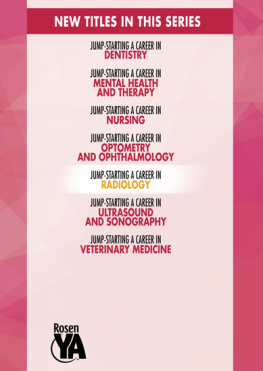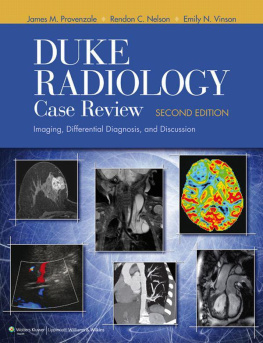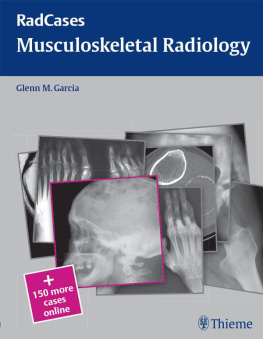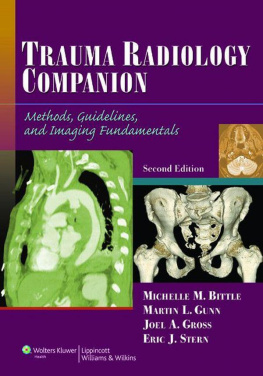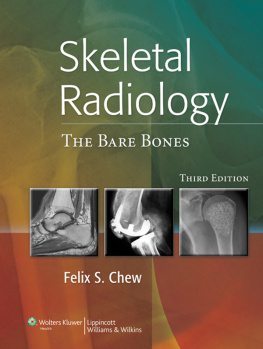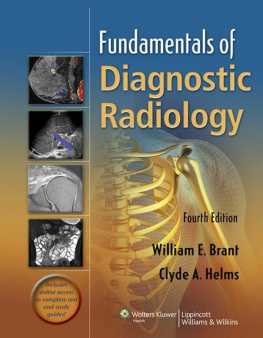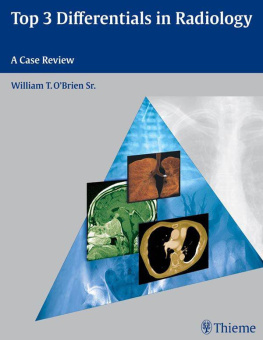Page List

Published in 2019 by The Rosen Publishing Group, Inc.
29 East 21st Street, New York, NY 10010
Copyright 2019 by The Rosen Publishing Group, Inc.
First Edition
All rights reserved. No part of this book may be reproduced in any form without permission in writing from the publisher, except by a reviewer.
Library of Congress Cataloging-in-Publication Data
Names: Porterfield, Jason, author.
Title: Jump-starting a career in radiology / Jason Porterfield.
Description: First edition. | New York: Rosen YA, 2019. | Series: Health care careers in 2 years | Audience: Grades 712. | Includes bibliographical references and index.
Identifiers: LCCN 2018010324 | ISBN 9781508185086 (library bound) | ISBN 9781508185079 (pbk.)
Subjects: LCSH: RadiologistsJuvenile literature. | Medical radiology Vocational guidanceJuvenile literature. | X-raysJuvenile literature.
Classification: LCC QC475.25 .P67 2019 | DDC
616.07/572/023dc23
LC record available at https://lccn.loc.gov/2018010324
Manufactured in the United States of America
CONTENTS
E ach day in a hospitals radiology department can be completely different from the day before. The day might start with routine checks of equipment to make sure everything is clean and in working order. After the patients start arriving, the work can be nonstop. It can be stressful and tiring, but also endlessly rewarding for the radiology technicians who work there.
Radiology technicians perform one of the most vital jobs in any hospital. They are thoroughly trained to use complex equipment to take images of the interior of peoples bodies. These might be X-rays of fractured bones or CT scans for problems with the cardiovascular system. Their work is to create the images that can best help the doctors make a solid diagnosis and start treating the patient. This task involves positioning the patient and the machine to create the clearest image possible.
The work, however, is more than simply putting the patient in a machine and pressing buttons until an image is created. The radiology technicians job includes figuring out the best way to position the patient to create a clear image. He or she will describe the procedure to the patient and answer questions that come up. The radiology technician might have to calm the patient down so that the procedure can go ahead. Radiology technicians spend a full day repeating the process, though with different patients. Theyll see all kinds of people and encounter a wide variety of injuries and ailments.

Radiology technicians care for patients of all ages as they go through imaging procedures. Here, a technician takes a boy through a magnetic resonance imaging (MRI) machine.
Radiology technicians training and their desire to help other people get better motivates them to perform well in their jobs. This training, which allows them to operate devices such as X-ray machines, can often be completed in fewer than two years at a community college or a hospital. Demand for radiology technicians is high, and the field is predicted to grow in the future. High school students who are interested in science and technology, and who have a strong desire to help people feel better, can expect to do well in the field.
After graduating and passing the necessary certification exams, a radiology technician is ready to begin a career in the field. Whether he or she focuses on one type of imaging device or earns the certifications needed to operate several types, there are numerous opportunities to produce high-quality images that can put patients on the road to recovery.
R adiology technicians are highly trained to use X-rays and sophisticated imaging equipment. Their work is vital to helping physicians and specialists find the cause of a patients symptoms. In their work, they collect diagnostic information through visual images produced by complex machines. The images they collect may show bones, internal organs, soft tissues, or the cardiovascular system. From these images, physicians can find or rule out causes and get the patient on the right path to treatment.
Radiology is a complex field. Radiology technicians, sometimes called radiographers, must understand how the machines they use work, know how to capture the best images possible, and be able to put the patients they see at ease. Despite the importance of what they do and the high level of technical knowledge required, radiology technicians can be licensed after just two years of training.
Ready for Anything
Most radiological departments are located in hospitals, though there are some in private clinics or in imaging centers. Hospital radiological departments take care of all the imaging work for all of the departments. They handle patients coming in from the emergency room, oncology, maternity, gynecology, neurology, orthopedics, and other areas of practice. Because they see patients from all departments, radiological department staffers work with people of all ages.

Obtaining clear images is vital to helping doctors decide on treatments. They should show the part of the body being treated from as many angles as possible.
The radiological departments function is to create images that are clear and can tell doctors everything they need to know about the part of the body in question. Good, clear images will help doctors pinpoint fractures, tumors, blockages, and other causes of their patients symptoms. An image might confirm the doctors initial ideas about whats causing the symptoms, or it could reveal something totally unexpected. A series of images taken while a patient is being treated can show how he or she has responded to treatment.
Radiology technicians are the people who operate the machines, position the patients to provide the clearest possible images, and make high-quality prints of the images for the doctors to examine. They must be prepared to perform professionally and methodically in all cases. This means following an established series of steps to create the images and maintaining a good rapport with doctors and patients. They must be able to stay calm when they are under pressure to create images or when a patient is uncooperative. Regardless of what is happening around them, they have to create the best images possible.
Hours and Challenges
A hospitals radiology department operates around the clock. There are busy times during standard work hours, when the greatest number of doctors are in the hospital. However, there may be a need at any time for a patient to have an X-ray or other image taken. This demand is especially true of hospitals with emergency rooms, where patients may be coming in at all hours.
Radiology technicians may have to work irregular hours to meet the hospitals needs. Some technicians work evenings, while others work overnight. They may be on a permanent schedule that has them working the same hours from week to week, or they may have to switch from time to time. Techs must be flexible in making plans, finding a good sleep pattern, and planning meals and family time.

